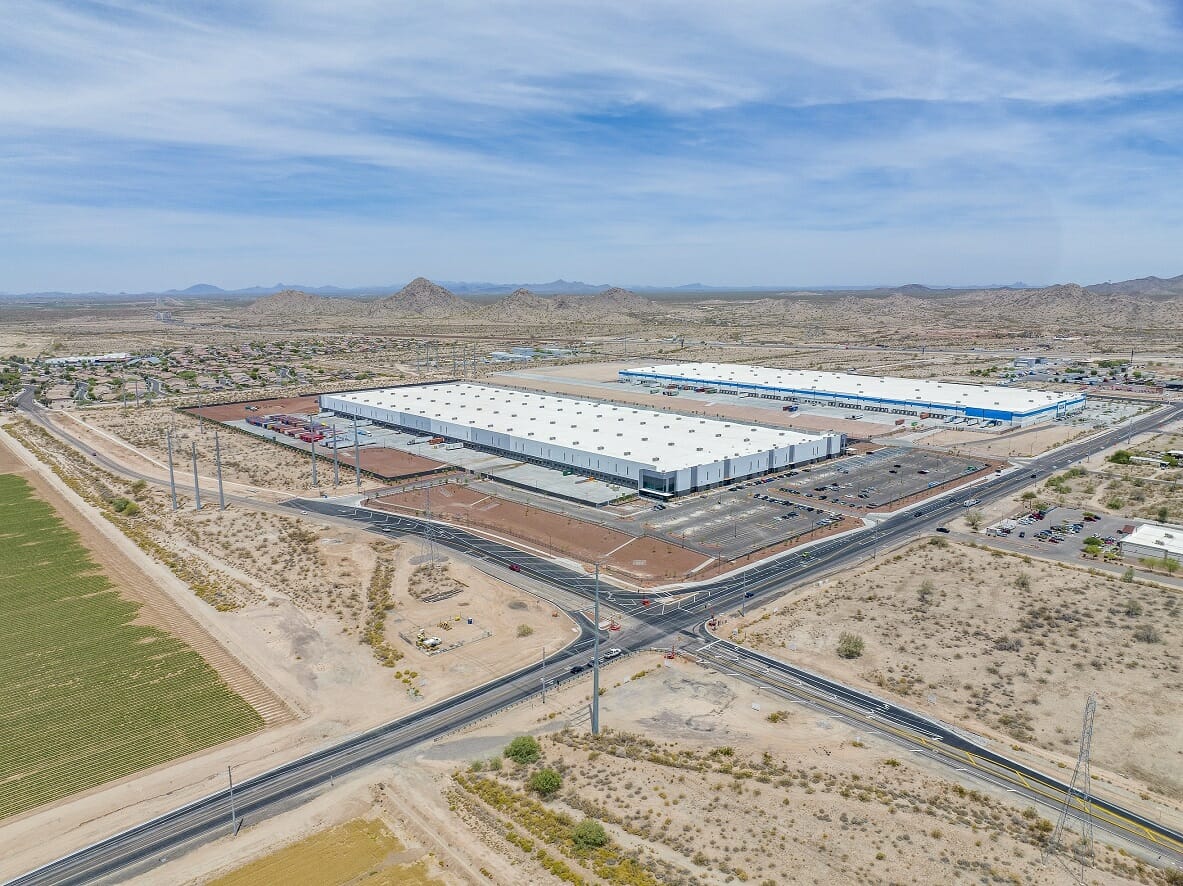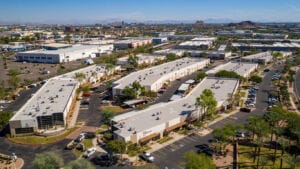Phoenix-based developer Creation announced on June 22, 2022, the sale of 10 West Commerce Park in Buckeye for $130 million — a new high-water mark for industrial building transactions within the municipality. The 860,602-square-foot facility — now home to a Funko distribution center — was sold to Intercontinental Real Estate Corporation in a joint venture with an affiliate of Cohen Asset Management.
“This transaction is significant because it cements Buckeye as the premier emerging industrial submarket in the Southwest Valley for employers,” says Grant Kingdon, vice president of transactions for Creation. “Investors and developers of employment facilities have taken note of the potential that exists in Buckeye and will continue to invest in the community, which will in return attract industry-leading employers to the area for many years to come.”
Will Strong, vice chairman at Cushman & Wakefield, notes that the origins of the deal can be traced back to another transaction in Buckeye that his company represented. Discount store chain Five Below chose the city to be the home of its Western U.S. distribution center, building an 850,000-square-foot facility that is expected to bring 290 jobs to the community over five years.
“Creation knew there was all this great tenant activity taking place, so they bought the land for [10 West Commerce Park] next to Five Below,” he says. “Funko showed up and leased it for 10 years, and they are moving their entire western U.S. operations into this building. And then we came in with an offer from Cohen Asset Management — who historically has been one of the largest and most active industrial buyers in the market — and they purchased it and we closed upon completion of the building.”
Tier 1 market
In a metro area like Greater Phoenix — which, to the outside observer, looks like one contiguous city — what is good for one municipality often aids others. Industries tend to cluster together, as evidenced by the growing electric vehicle sector in the East Valley and Pinal County. As more companies see Metro Phoenix as a viable place to do business, communities — including Buckeye — prosper.
“The Phoenix Metro is the beneficiary of a handful of unique market tailwinds,” Kingdon explains. “The first is our proximity to the land-constrained and expensive Inland Empire. As rental rates and land pricing in the Inland Empire continue to soar at record rates, tenants are looking to other markets for cost-effective options. The Phoenix Metro (Southwest Valley in particular) is the most logical option to relocate to from the Inland Empire.”
10 West Commerce Park is one example of that dynamic, having not only broken the record for highest gross industrial building sale in Buckeye but was also the first in the city to be built speculatively. Without evidence of sufficient demand, building speculatively can be a risky proposition.
READ ALSO: Here’s why $142.5M West Valley land deal took decades to close
“Phoenix historically had a rap for being this boom-and-bust housing town,” Strong says. “But all these companies have come here over the last 10 years. We used to do 5 million square feet of net absorption. Last year, we did 27 million feet, and we’re going to blow past that this year. My gut intuition tells me 70% of what’s on the market right now is committed to in one way or the other, whether it’s officially been leased out by a company, or it’s more likely than not that a user is going to take the building.”
Many users, Strong continues, want to be as close to California as possible, but they also need labor, a pro-business community and housing for employees. He describes Buckeye as “ground zero” for companies searching for locations that fit that description.
“Phoenix is now looked upon as a primary market,” Strong notes. “We have all the diversity in the economy that you would expect from a very mature market. [Capitalization] rates and pricing are moving in this interest rate environment, the same direction as other primary markets.”
Kingdon agrees, adding, “Despite broad market volatility, industrial building sales in Phoenix will continue to trade. Phoenix has transitioned into a Tier 1 coastal gateway market that continues to attract industry-leading investors.”
Can it last?
As more businesses choose to locate in the Valley, the effects of supply and demand have made their mark on the market. A Kidder Matthews second quarter 2022 industrial market report notes that “Investors are bullish on the Phoenix industrial market and strong buyer competition has driven sales prices to an all-time high of $171 [per square foot] in [the second quarter]. The buyer pool has deepened in the local market, especially with California-based investors that seek affordability and value when compared to their own state.”
Even with elevated prices, Strong believes Greater Phoenix is still well positioned to attract more investment. “The rents have so much more room to grow, so there’s a lot of intrinsic value that exists in these buildings,” he concludes. “Buildings and land sell for two and three times in Southern California and other places, so if you compare Phoenix to some of these other markets, it’s not even close. Even prices are inching up, there’s still a ton of room to run.”




